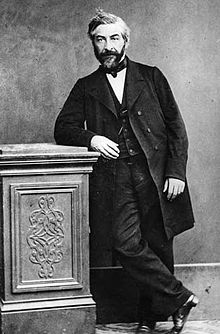Ytterbium
Ytterbium [ʏˈtɛrbiʊm, ![]() ] is a chemical element with the element symbol Yb and atomic number 70. In the periodic table, it is in the lanthanide group and is thus also one of the rare earth metals. Like the other lanthanides, ytterbium is a shiny silver heavy metal. The properties of ytterbium do not follow the lanthanide contraction, and due to its electron configuration, the element has a significantly lower density and a lower melting and boiling point than the neighboring elements.
] is a chemical element with the element symbol Yb and atomic number 70. In the periodic table, it is in the lanthanide group and is thus also one of the rare earth metals. Like the other lanthanides, ytterbium is a shiny silver heavy metal. The properties of ytterbium do not follow the lanthanide contraction, and due to its electron configuration, the element has a significantly lower density and a lower melting and boiling point than the neighboring elements.
Ytterbium was discovered in 1878 by Jean Charles Galissard de Marignac while studying gadolinite. In 1907 Georges Urbain, Carl Auer von Welsbach and Charles James independently separated another element, lutetium, from Marignac's ytterbium. The previous name was retained after a lengthy discussion, contrary to the wishes of Welsbach, who had suggested aldebaranium.
Technically, the element and its compounds are used only in small quantities due to the complicated separation from the other lanthanides, among other things as dopants for yttrium-aluminum-garnet lasers. Ytterbium(III) chloride and ytterbium(II) iodide are reagents in various organic synthesis reactions.
History
Ytterbium was discovered in 1878 by the Swiss chemist Jean Charles Galissard de Marignac. He examined gadolinite more closely and tried to separate the insoluble erbium from the other mineral components by decomposing nitrates in hot water. In doing so, he discovered that the crystals obtained did not consist uniformly of red erbium nitrate, but that other colourless crystals remained. The measured absorption spectrum showed that these must be crystals of a previously unknown element. He named this element ytterbium after the place where the gadolinite was found in Ytterby (Sweden) and because of its similarity to yttrium. A separation of the two elements was achieved in another experiment by adding hyposulphurous acid to a solution of the chlorides.
In 1907, the Frenchman Georges Urbain, the Austrian Carl Auer von Welsbach and the American Charles James independently recognized that the ytterbium found by Marignac was not a pure element but a mixture of two elements. They were able to separate this mixture into the now pure ytterbium and lutetium. Carl Auer von Welsbach named the elements aldebaranium (after the star Aldebaran) and cassiopeium, while Urbain specified neoytterbium and lutetium as the names. In 1909, it was determined by the International Atomic Weight Committee, consisting of Frank Wigglesworth Clarke, Wilhelm Ostwald, Thomas Edward Thorpe, and Georges Urbain, that Urbain was entitled to the discovery of lutetium, and thus the names he determined would stand. However, the old name of Marignac was retained for the ytterbium.
Elemental ytterbium was first obtained in 1936 by Wilhelm Klemm and Heinrich Bommer. They obtained the metal by reduction of ytterbium(III) chloride with potassium at 250 °C. Furthermore, they determined the crystal structure and the magnetic properties of the metal.

Jean Charles Galissard de Marignac
Extraction and presentation
The extraction of ytterbium is complicated and lengthy, mainly due to the difficult separation of the lanthanides. The starting minerals such as monazite or xenotime are first digested with acids or alkalis and brought into solution. The separation of ytterbium from the other lanthanides is then possible by various methods, with separation by ion exchange being the most technically important method for ytterbium, as well as for other rare lanthanides. In this process, the solution containing the rare earths is applied to a suitable resin to which the individual lanthanide ions bind to varying degrees. They are then dissolved from the resin in a separation column with the aid of complexing agents such as EDTA, DTPA or HEDTA, and the separation of the individual lanthanides is thus achieved by the different strength of binding to the resin.
Chemical separation is possible via different reactions of ytterbium, lutetium and thulium acetate with sodium amalgam. Ytterbium forms an amalgam, while the lutetium and thulium compounds do not react.
Metallic ytterbium can be obtained by electrolysis of a melt of ytterbium(III) fluoride and ytterbium(III) chloride, with alkali or alkaline earth metal halides for melting point reduction, and liquid cadmium or zinc as cathode. Besides, it can also be prepared by metallothermic reduction of ytterbium(III) fluoride with calcium, or ytterbium(III) oxide with lanthanum or cerium. If the latter reaction is carried out in a vacuum, ytterbium distills off and can thus be separated from other lanthanides.

Ytterbium
Search within the encyclopedia